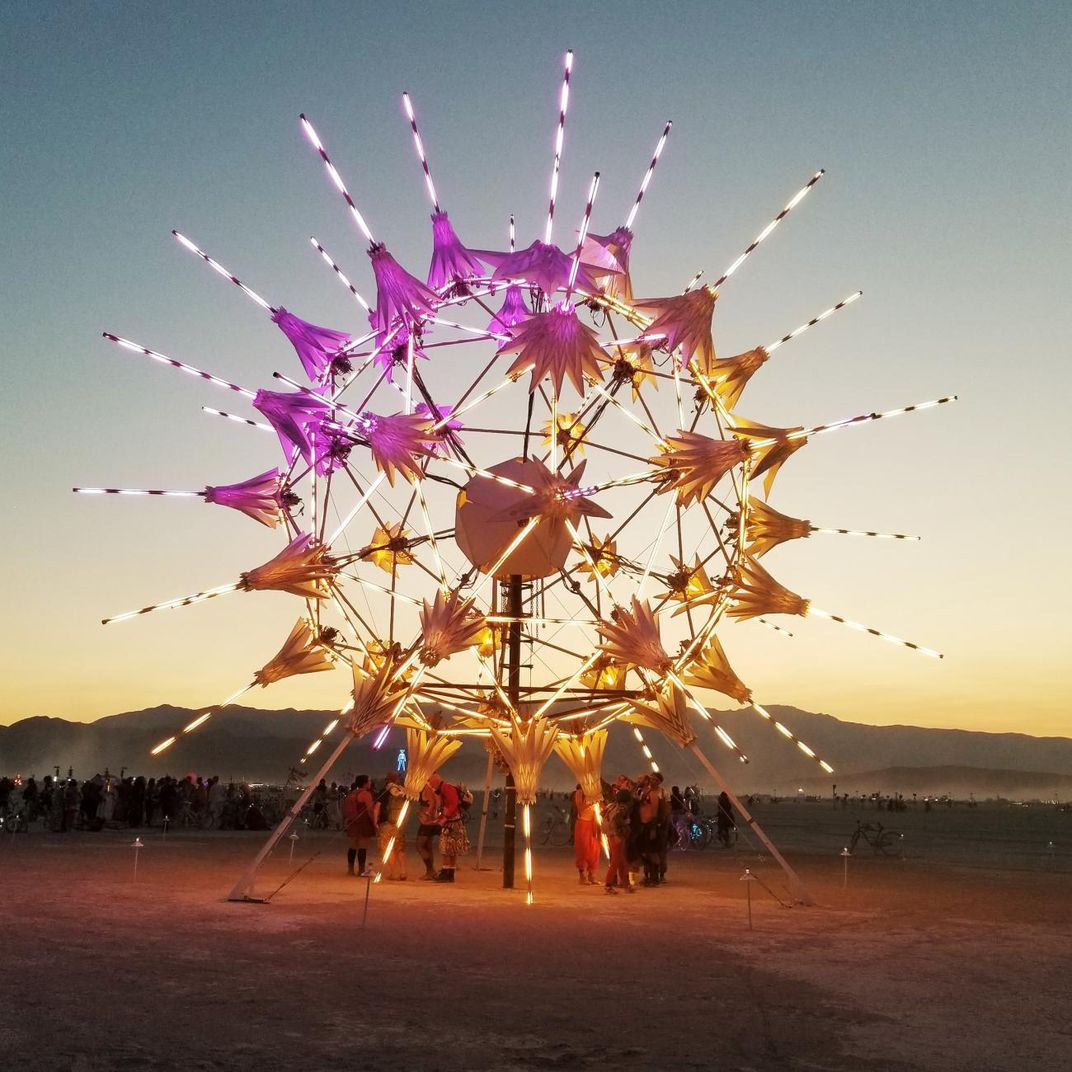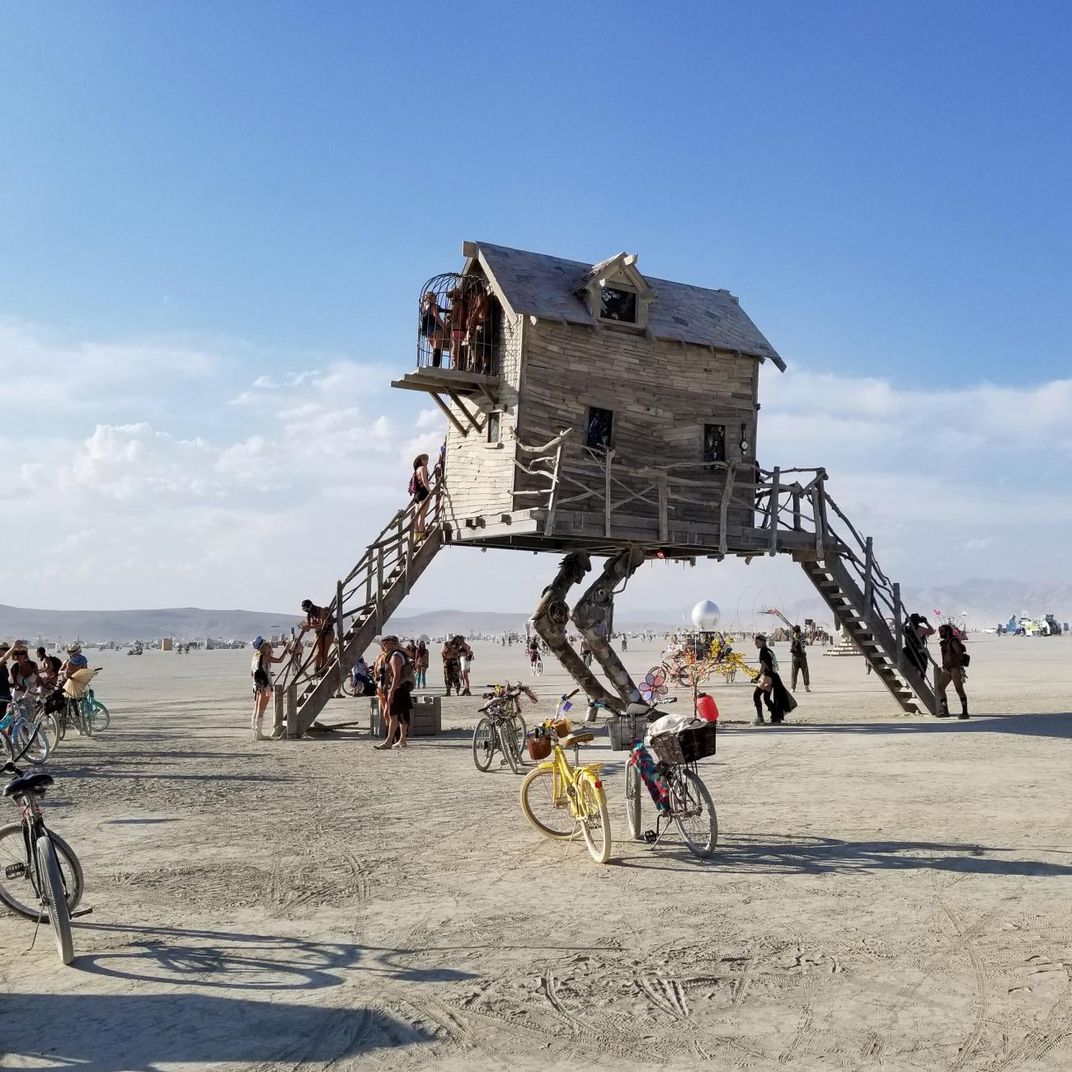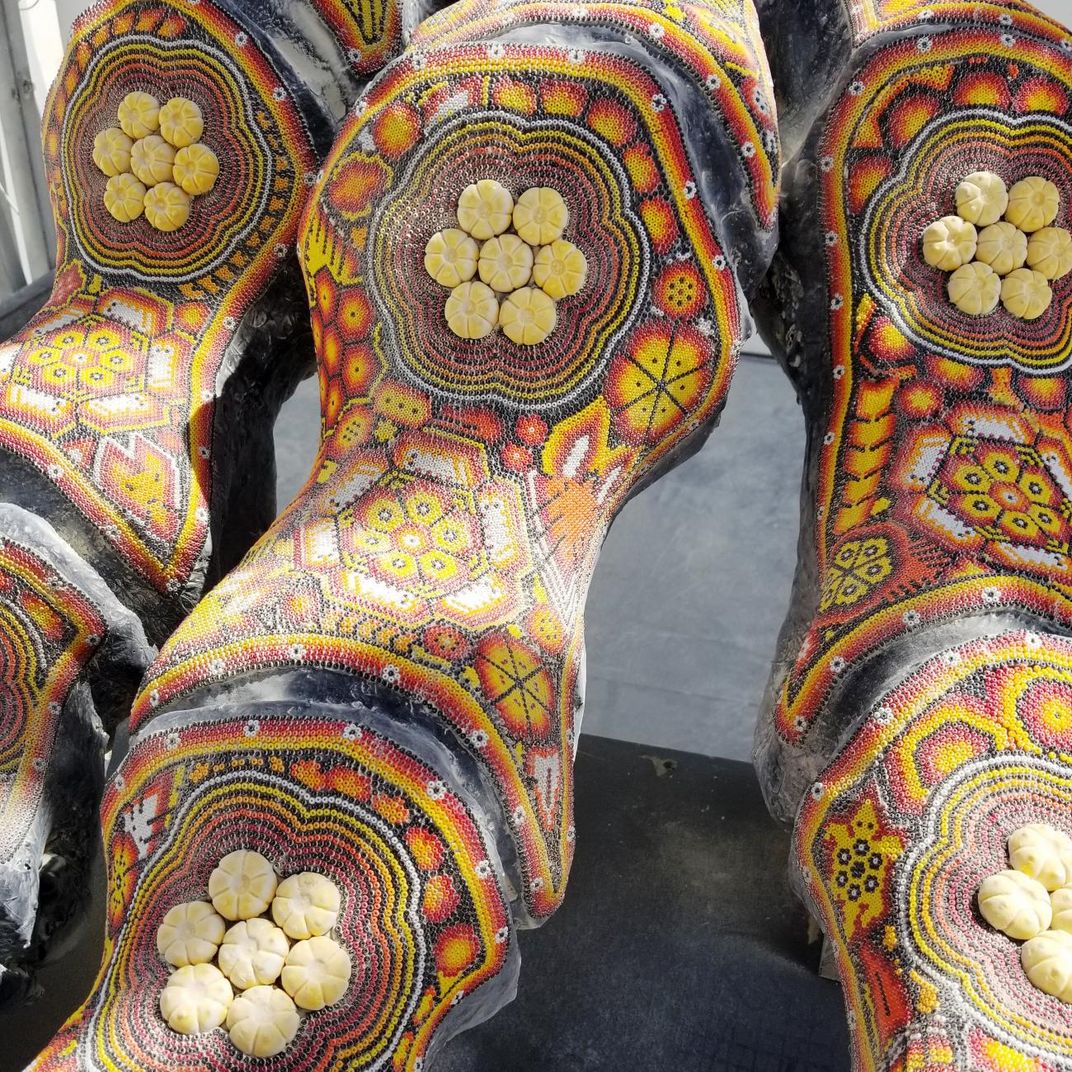SMITHSONIAN AMERICAN ART MUSEUM AND THE RENWICK GALLERY
Embrace the Dust: A Burning Man Journal
A personal journal by a museum educator and first time Burner.
/https://tf-cmsv2-smithsonianmag-media.s3.amazonaws.com/blogging/featured/playaselfie.jpg)
I came for the art. Also for the adventure. There are as many reasons to go to Burning Man as there are citizens in Black Rock City, the temporary community that rises from the Nevada dust every August. The desert is less sand dunes and sidewinders, and more hard-baked earth and white dust. While you live in Black Rock City, the dust is the dominant feature of your life. It gets everywhere and sticks to everything. You learn to quickly embrace it and in truth it’s one of the things about Burning Man that binds everyone together in the end; embrace the dust. The dust is an integral element of the Black Rock Desert where nature is trying to kill you, but as the dust coats you it almost becomes your armor against the sun, the heat, and the wind. Perhaps it envelopes you to make you as much a part of the desert as it is. Whatever its intent, the dust is something that everything and everyone must contend with: the people, the vehicles, the camps, and even the art.

When I arrived on Playa, exhausted from almost 16 hours of travel, I only had a vague inkling of the significance of the dust. I heard folks talk about it, in fact most burners and artists mentioned it. I was told of “Playa foot,” a condition caused by the alkaline nature of the dust. Some burners told me of their first time on Playa and the burning they experienced in their lungs when they breathed in the dust. Shrumen Lumen, the installation by the FoldHaus Art Collective, still had dust on it when No Spectators: The Art of Burning Man opened at the Renwick in March (the playa dust is likely embedded forever in its folds). When I eventually found my camp—it luckily wasn’t difficult to locate on the clock face layout of the streets—I was greeted with “Are you Geoff? Welcome home!” It was with genuine warmth and excitement that isn’t common in the “default world” when you meet strangers. But this was Burning Man. Everyone gathered around and hugged me. Then came the ritual that all first-timers must complete, it was time that I embraced the dust. It involved lying down on the ground, rolling back and forth until I was covered, and then making a dust angel. Once I finished, I rang a bell as loud as I could. It was all good fun and honestly as much as you may wish to avoid the dust that’s a losing endeavor. You may as well acquiesce sooner rather than later. I was tired, dazed, confused, overwhelmed, and anxious but I was at Burning Man and it was awesome!

It wasn’t until the next day that I began to fully appreciate the enormity of the Playa. I spent much of the day biking around with several of my campmates, mostly burgins (virgin burners) like me. We visited Baba Yaga’s House, a fully sensorial immersive work. Baba Yaga is the witch from Slavic folklore who lives in a house on chicken legs. We climbed up the narrow staircase to her front door. The witch wasn’t home which gave us free reign to explore. Had she been home we could have been denied entry or if we were lucky she may have cast our fortunes. Baba Yaga is a fickle mistress. We then encountered a husband and wife driving around playa in tiny cupcake bikes, their heads poking out from the top like candied cherries. We found the pen with iSheep, an installation created by local DC burners. One of my campmates was the voice of one of the sheep. We petted and scratched each sheep to get them to speak until we finally heard her voice. We rode to the Temple but it was closed while the architect and his crew completed the final touches to the structure. It was beautiful. I returned to the Temple again and again while I was there.

One morning I was fortunate to be invited to join a tour of the art via an art car, The Lady Washington. We were still in the middle of a dust storm, although it wasn’t as strong as the night before. We passed Baba Yaga’s House again, then a pair of giant cellos, then we came upon two metal dinosaur skeletons—a velafrons and tyrannosaurus. Each skeleton covered in the hand-laid beadwork of the Huichol, the indigenous peoples that live in the same Mexican region that the velafrons once lived. From a distance they looked like any other fossil recreations, but as you stepped closer the intricate designs and vivid colors of the beads drew you in. After investigating the skeletons, entitled ICHIRO Scared Beings, we disembarked again. We came to a giant polar bear made entirely of old car hoods before driving to the Temple, this time it was open and burners had begun to leave their offerings. It was alive with a powerful silence. Our art guides allowed us extra time at the Temple. Then we continued on to see a few more pieces before stopping at the Man. They let us explore the platform the Man stood on. It was the perfect end to a two hour, by this time the winds were dying down and the dust subsiding.

Later that night, I witnessed my first burn. There’s something rather fascinating about watching a work of art burned to ground. Many of the artworks take months of planning and designing before they’re constructed on Playa. Sometimes the works are never completed. The artists get out on Playa where the dust and weather bring construction to a halt. Most works built on Playa have been successfully completed, though there will be unforeseen complications. And most of the art is not burned. So when you sit and watch a piece burn it’s bittersweet. It was intended to burn, but the work represents thousands of hours of work, dedication, and passion. Then within an hour it’s all consumed by flame. It’s a release, it’s a ritual, and it’s a rebirth.
I never planned my days at Burning Man. I let the each day unfold as it may. There was no possible way that I could have seen all the art, but I tried to see as much of it as possible. But there was always something more to do and sometimes the dust directed you somewhere else. I remember that for the weeks before I left as I met burner after burner, a common refrain was that Burning Man would be transformative. I resisted that idea, not because I believed it wouldn’t be. Rather it was that I don’t want to go in to the experience with that high expectation. What would happen then if the experience wasn’t transformative? The trip would be a failure. Now several months later, I still think about that question, whether it was transformative or not. What I am sure of is that the experience, the people, the art—and the dust—will forever be a part of me. I may not be a new person but I am a different person; I am a better person; and the people I met, the art I saw, the experience I had, and the dust will forever be a part of my life whether I want it to be or not.

